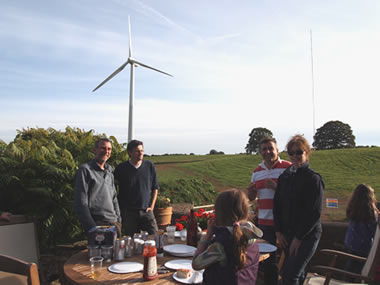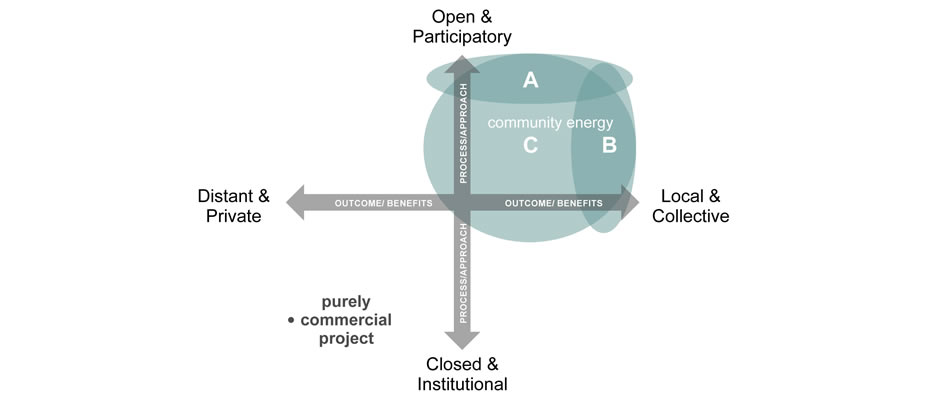- info@theresiliencecentre.co.uk
- +44 (0)1594 529688
What is Community Energy?
The Community Approach
Community energy projects come in many shapes and sizes. Some projects or initiatives are focused on generating renewable energy whilst others focus on managing or reducing energy use or collective purchasing of energy to reduce costs.
The factors that define a ‘community’ may also be diverse and include geography, identity or interest. The benefits of community energy are influenced not only by who is involved, but also by how they are involved and where benefits accrue.
Community Energy projects generally have the following aims:
- To reduce greenhouse gas emissions associated with energy generation and use
- To re-connect people with how energy is generated and consumed
- To improve energy security
- To generate employment opportunities
- To support the local economy
Given the wide range of projects, approaches and structures available, a consistent definition of Community Energy has proved difficult. However, there is an increasing consensus that a Community Energy project is one which combines elements of local and collective benefits and an open participatory approach.
In addition to the aims listed above, our Resilient Energy approach provides opportunities for community investment whereby local people have the first opportunity to invest in a project and share in the operating returns. Our projects also have additional community benefits through our establishment of community funds for each host community to help build community resilience. This encourages local applicants to the fund to consider current community needs and future challenges
We pioneered this approach in 2010 in our own back yard and we firmly believe it can yield maximum benefits for all concerned, with up to 75% of a project’s lifetime money flow retained within the local economy.
The innovative approach pioneered by The Resilience Centre was endorsed by think tank ResPublica and the Energy Minister Rt. Hon Greg Barker in a recent Green paper. The Government Community Energy Strategy confirms support for considerable growth in the sector and emphasises a specific need for community focussed partnerships. We are delighted with the affirmation that such an approach is now recommended to increase the proportion of community renewables in the UK
energy mix.



Given the wide range of projects, approaches and structures available, combined with recent innovations, a clear and consistent definition of Community Energy has often proved elusive for the evolving sector. However, there is an increasing consensus (based on 2008 research by Gordon Walker and Patrick Devine-Wright) that a Community Energy project is one which combines elements of both local and collective benefits in terms of its outcomes with a degree of open participatory processes in its approach.
Their helpful figure, reproduced with the kind permission of the authors, provides a helpful benchmark mechanism, with community energy projects clearly defined as those falling mainly within the top right quadrant and purely commercial projects lying within the lower left quadrant. The authors’ research identified three common responses to interpretations of community energy (Areas A, B and C on the diagram).
Viewpoint A focuses on the Process dimension and sees community projects as necessarily needing a high degree of local involvement in the planning, setting up and potentially running of a project. This viewpoint is driven by principles of empowerment, participation and capacity building.
Viewpoint B focusses on the Outcome dimension and is often less concerned with who is participating in a project than with where the benefits are distributed. This viewpoint is driven by those who are happy with more flexible approaches to how projects are conceived, set up and managed as long as they particularly benefit the local community (eg through jobs, regeneration or other social benefit) in addition to the wider benefits of carbon reduction.
Viewpoint C embraces broader diversity in the types of project afforded a community label. This viewpoint is less concerned with whether a project ticks the right ‘community’ boxes, than whether the results are actually something productive and useful. In this viewpoint many combinations of process and outcome are therefore acceptable.
Adapted from the following Source: Walker, G. & Devine-Wright, P. 2008. Community renewable energy: What should it mean? Energy policy, 36, 497 - 500.
In addition to the aims listed above, our Resilient Energy approach provides opportunities for community investment whereby local people have the first opportunity to invest in a project and share in the operating returns. Our projects also have additional community benefits through our establishment of community funds for each host community to help support other initiatives to build community resilience. This has additional social benefits by encouraging the community to address both its current needs and future challenges. Given our early community engagement, and the high level of local support, involvement and benefits, we see our approach as consistent with all three viewpoints of what constitutes a Community Energy project.
We pioneered our Resilient Energy community approach in 2010 in our own back yard (Gloucestershire) and are now replicating and adapting our model to suit each project we take forward both locally and further afield. We firmly believe it can yield maximum community benefits, with up to 80% of a project’s lifetime money flow retained within the local economy.

